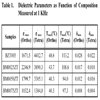
The Open Condensed Matter Physics Journal
(Discontinued)
ISSN: 1874-1924 ― Volume 4, 2013
Effects of Mg Addition on Phase Transition and Dielectric Properties of Ba(Zr0.05Ti0.95)O3 System
A. Quintana-Nedelcos*, 1, A. Fundora2, H. Amorín3 , J.M. Siqueiros4
Abstract
Samples were prepared by conventional powder mixing procedure. The starting powder MgCO3, BaCO3, TiO2 and ZrO2 (ALFA AESAR 99.9% pure) was weighed according to the formula (1-x) BaCO3 + x MgCO3 + 0.95TiO2 + 0.05ZrO2. x was varied from 0.025, 0.050 and 0.075. The XRD study at room temperature suggests that ceramics have pseudo cubic symmetry phase. The behavior of the measured dielectric permittivity and dielectric loss with temperature and frequency reveals that the materials undergo a diffuse para-ferroelectric phase transition and are of the relaxor type. The dielectric properties corresponding to our samples show very low remnant polarization in their hysteresis loop, this result can be explained by the substitution of ion Ba2+ by Mg2+, having both a large difference in their respective ionic size, with a disorder in the structure of the system, also in site B we have two different elements (Zr and Ti), in consequence of both kind of structural defects we have a weakness in long terms of dipolar interaction, reducing the stability of the ferroelectric phase. In the sample obtained with a higher grain size, a presence of an anti-ferroelectric phase is suggested, while in the others two samples this result it is not appreciable, due to their very small grain size, but a very thin hysteric loop was a result of depressed ferroelectric behavior.
Article Information
Identifiers and Pagination:
Year: 2009Volume: 2
First Page: 1
Last Page: 8
Publisher Id: TOCMPJ-2-1
DOI: 10.2174/1874186X00902010001
Article History:
Received Date: 5/11/2008Revision Received Date: 2/12/2008
Acceptance Date: 13/12/2008
Electronic publication date: 29/1/2009
Collection year: 2009
open-access license: This is an open access article licensed under the terms of the Creative Commons Attribution Non-Commercial License (http: //creativecommons.org/licenses/by-nc/3.0/ which permits unrestricted, non-commercial use, distribution and reproduction in any medium, provided the work is properly cited.
* Address correspondence to this author at the Instituto Superior Politécnico “José A. Echeverría” (CUJAE), Calle 114, Num 11901, Marianao C. Habana, CP 10400, Cuba; aris.qn@electrica.cujae.edu.cu, arisqn@gmail.com
| Open Peer Review Details | |||
|---|---|---|---|
| Manuscript submitted on 5-11-2008 |
Original Manuscript | Effects of Mg Addition on Phase Transition and Dielectric Properties of Ba(Zr0.05Ti0.95)O3 System | |
1. INTRODUCTION
Pb(Zr,Ti)O3 (PZT)-based piezoelectric ceramics has been study more than anyone else ferroelectric because of their excellent piezoelectric properties [1]. However, the presence of lead in those materials is about 60 % in weight [2], reconsidering its use in technical applications, due to the high toxicity of lead for the environment as well as for humans.
Recently have been reported some materials as (K0:44Na0:52Li0:04)(Nb0:84Ta0:10-Sb0:06)O3 [2] and (Na0.5K0.5)l−x (LiSb)xNbl−xO3 [3], showing excellent piezoelectric properties, similar to those corresponding to PZT systems, however, there are still problems such as the use of alkaline metals, their use being very difficult where semiconductor-based technologies are used.
BaTiO3 (BTO)-based systems have been known to be strong candidates in the race for lead free ferroelectrics materials [4-6]. One of the most reported variants is Ba(ZrxTi1-x)O3 (BZT) [7]. Due to their high permittivity, these materials are used frequently in commercial capacitor applications, at the same time it is a very promising material for DRAM memory and micro-electromechanic systems (MEMS) applications [6]. Some papers suggest A- and B- sites compositional modifications in ABO3 ferroelectric materials can arise the antiferroelectric double hysteresis loops [8-10], and diffuse phase transitions are caused by the compositional fluctuation of a particular ion at the B site and the concentration of different types of ions in the crystal lattice. The transitions may also become diffused due to grain boundary effects [11, 12].
When Ba ion is substituted by Mg ion in a BZT system, a great structural disorder is espected, arasing changes in dielectric and ferroelectric properties of samples. This motivated us to work on effects off Mg substitution. We present results obtained in the study of phase transition and dielectric properties of B(Zr0.05Ti0.95)O3 by hysteresis loop where Mg2+ was added, obtaining Ba1-xMgx(Zr0.005Ti0.095)O3 with x = 0.025; 0.050; and 0.075.
2. EXPERIMENTAL PROCEDURE
The samples were prepared by the conventional solid state reaction procedure. The starting powders MgCO3, BaCO3, TiO2 and ZrO2 (ALFA AESAR 99.9% pure) were weighed according to the formula (1-x) BaCO3 + x MgCO3 + 0.95TiO2 + 0.05ZrO2. x was given the values 0.025, 0.050 and 0.075. The powders were mixed in a Zr ball mill and sintered afterward at 1300oC for 2 hours at a rate of 1Co/min. For practical purposes the samples will be coded as follows: Ba(Zr0.05Ti0.95)O3, BZT005; Ba0.975Mg0.025(Zr0.05Ti0.95)O3, BM0025ZT; Ba0.950Mg0.050(Zr0.05Ti0.95)O3, BM0050ZT and Ba0.925Mg0.075(Zr0.05Ti0.95)O3, BM0075ZT.
X-ray diffraction (XRD) studies were performed on the samples using Cu Kα radiation between 20 and 70 degrees with a scanning step of 0.5 degree. Dielectric measurements were carried out in the 25-200oC temperature range, using an HP3238 capacitor analyzer in the 1 kHz to 1 MHz frequency range. The hysteretic loop was obtained with a RT66A (Radiant Technologies).
3. RESULTS AND DISCUSSION
Fig. (1 ) shows the XRD patterns obtained for BZT, BM025ZT, BM050ZT and BM075ZT. In all cases the presence of a perovskite structure is observed but not the same crystal phase. The pattern for BZT005 corresponds to a tetragonal perovskite structure whereas for BM0025ZT, BM0050ZT and BM0075ZT a pseudo cubic structure is observed. Due to the differences in length of the ionic diameter between Ba2+ and Mg2+, mechanical stress was introduced into the lattice during cooling after sintering process, leading the transition from tetragonal structure in BZT005 to a pseudocubic structure in BMZT systems.
) shows the XRD patterns obtained for BZT, BM025ZT, BM050ZT and BM075ZT. In all cases the presence of a perovskite structure is observed but not the same crystal phase. The pattern for BZT005 corresponds to a tetragonal perovskite structure whereas for BM0025ZT, BM0050ZT and BM0075ZT a pseudo cubic structure is observed. Due to the differences in length of the ionic diameter between Ba2+ and Mg2+, mechanical stress was introduced into the lattice during cooling after sintering process, leading the transition from tetragonal structure in BZT005 to a pseudocubic structure in BMZT systems.
 |
Fig. (1) X-ray patterns of BZT005, BM0025ZT, BM0050ZT and BM0075ZT. |
Fig. (2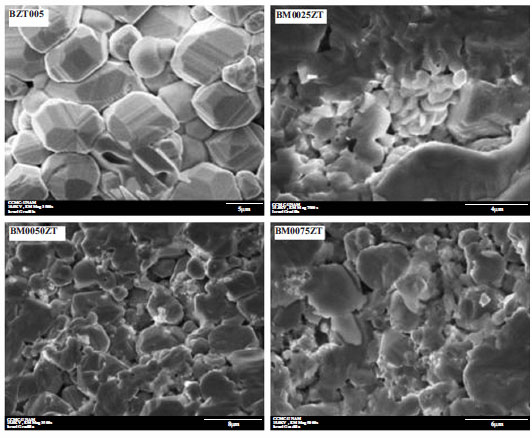 ) shows SEM images of the BZT005, BM0025ZT, BM0050ZT and BM0075ZT samples. From these images the average grain size and their relative error were estimated. results are 6.3; 1.4; 3.2; 2.8 respectivily.
) shows SEM images of the BZT005, BM0025ZT, BM0050ZT and BM0075ZT samples. From these images the average grain size and their relative error were estimated. results are 6.3; 1.4; 3.2; 2.8 respectivily.
 |
Fig. (2) SEM images. |
In all cases, bulks reveals high granular density. It is obviously with the addition of Mg the average granular diameter decrease considerable, in comparison to the granular diameter of BZT005 sample. In bulks where Mg2+ ion was added, grains shows faces not well developed as in BZT005, indicating that the growing up process of grains is highly frustrated by short-range forces. Dou to the differences in large of the ionic diameter between Ba2+ and Mg2+ a mechanical stress was introduced into the lattice during cooling after sintering process, this electromechanical stress increased the energy in the grain boundaries interface, decreasing the kinetic diffusion of ions trough the boundary and as consequence the movement of the grain boundary [13]. Because of the high role played by the short-range forces with the inclusion of Mg, more macrodomains (long–range ordered regions) will breakup into micropolar regions, independent of eachother, in detriment to the ferroelectric response of the ceramic.
Studies of the variation of dielectric permittivity (ε´) with temperature for BZT005, BM0025ZT, BM0050ZT and BM0075ZT at different frequencies show the presence of two peaks coinciding with those reported in Landolt-Börnstein [14] for BZT005, as can be seen in Fig. (3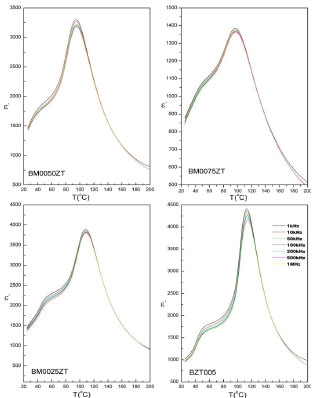 ). The dielectric permittivity shows broad transitions normally associated to diffusive relaxor ferroelectrics. The shift of the peak due to permittivity dispersion with frequency gets smaller with the increase of Mg2+ addition.
). The dielectric permittivity shows broad transitions normally associated to diffusive relaxor ferroelectrics. The shift of the peak due to permittivity dispersion with frequency gets smaller with the increase of Mg2+ addition.
 |
Fig. (3) Dielectric permittivity for BZT005, BM0025ZT, BM0050ZT and BM0075ZT. |
It is known that one characteristic that must be present in a material with diffuse phase transition is a relatively large separation (in temperature) between the maxima of the real (dielectric constant) and imaginary (dielectric loss) part of the dielectric permittivity. Fig. (4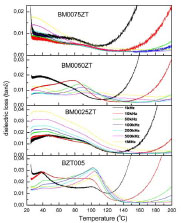 ) shows the temperature dependence of the dielectric loss of BZT005, BM0025ZT, BM0050ZT and BM0075ZT ceramics. In all cases, it is seen that the values of the temperatures of the maximum of dielectric permittivity and the maximum of the dielectric losses do not coincide. This result corroborates we are in the presence of a diffuse phase transition [15]. Also in Fig. (4
) shows the temperature dependence of the dielectric loss of BZT005, BM0025ZT, BM0050ZT and BM0075ZT ceramics. In all cases, it is seen that the values of the temperatures of the maximum of dielectric permittivity and the maximum of the dielectric losses do not coincide. This result corroborates we are in the presence of a diffuse phase transition [15]. Also in Fig. (4 ) an anomalous behavior is observed in all cases. Such behavior is related to the variation of the dipolar moment originated by the substitution of Mg2+ ions at Ba2+ sites. The temperature corresponding to the orthorhombic – tetragonal transition varies with the content of Mg2+.
) an anomalous behavior is observed in all cases. Such behavior is related to the variation of the dipolar moment originated by the substitution of Mg2+ ions at Ba2+ sites. The temperature corresponding to the orthorhombic – tetragonal transition varies with the content of Mg2+.
 |
Fig. (4) Dielectric loss for BZT005, BM0025ZT, BM0050ZT and BM0075ZT. |
Table 1 shows the obtained values of the dielectric constant at 1 KHz and how they decrease with the increase in Mg content. The temperature corresponds to the maximum of the dielectric loss in the BM0075ZT sample (corresponding to the tetragonal-cubic transition) is slightly higher than that of BM0050ZT.
The decrease of Tmax(oC) with the increment of the Mg2+doping, may be associated to the increment of cationic disorder at the A-site in the perovskite structure as the Mg2+ ions are incorporated into the system. Ba2+ and Mg2+ will occupy the same crystallographic site. However, the ionic radius of Ba2+ is much larger than that of Mg2+ and the structure will be distorted. Furthermore, B site is occupied by Zr4+ and Ti4+ in a random way, with Zr at a fixed percent of 0.05%, generating defects that added to the effects of the Mg2+ ions will weaken the long range dipolar interactions [16], reducing the stability of the ferroelectric phase.
In Fig. (5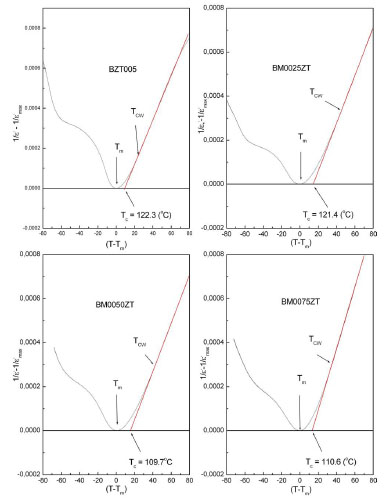 ) we can distinguish 3 regions: 1- for the ferroelectric phase, with temperatures below Tm of the dielectric permittivity maximum. 2- Diffuse phase region 3- paraelectric phase up to Tcw, reaffirming the diffuse character of our system.
) we can distinguish 3 regions: 1- for the ferroelectric phase, with temperatures below Tm of the dielectric permittivity maximum. 2- Diffuse phase region 3- paraelectric phase up to Tcw, reaffirming the diffuse character of our system.
 |
Fig. (5) 1/ε´-1/ε´max vs T-Tm and the lineal fit of the paraelectric region for BZT005, BM0025ZT, BM0050ZT and BM0075ZT. |
Because of the Curie-Weiss law does not explain the diffuse interval of the curve [17]; a modified Curie-Weiss law, Equation 1, was proposed to describe the diffuseness of the phase transition.
where γ (1<γ<2) and C are assumed to be constant. The known forms of Curie-Weiss and squared Curie-Weiss laws are particular cases of the Equation 1 with γ = 1 and γ = 2 respectively. Through some algebraic manipulation and by fitting the experimental measurements the value of γ can be obtained. The procedure is illustrated in Fig. (6 ) with the respective values of γ obtained for each material.
) with the respective values of γ obtained for each material.
 |
Fig. (6) ln(1/ε´-1/ε´max) vs (T-Tm) for BZT005, BM0025ZT, BM0050ZT and BM0075ZT. |
In the studied ceramics the values of γ are found to be higher than 1.5 and for those with Mg higher than 1.6 at 1 KHz, indicating diffuse transitions. The increase of the diffuseness as measured by the value of γ evidently increases with the increase of Mg2+ concentration.
Fig. (7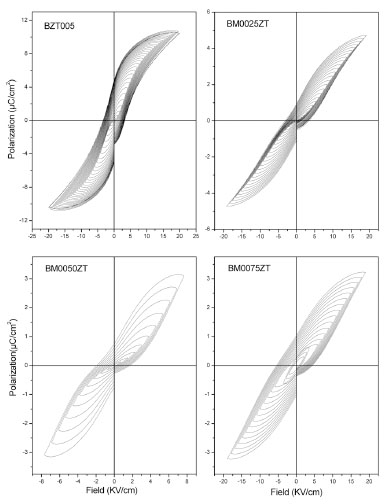 ) shows the hysteresis loops corresponding to the BZT005, BM0025ZT, BM0050ZT and BM0075ZT samples. In all of them typical hysteresis loop behavior is notable in the materials polarization (P) vs electric field (E) response.
) shows the hysteresis loops corresponding to the BZT005, BM0025ZT, BM0050ZT and BM0075ZT samples. In all of them typical hysteresis loop behavior is notable in the materials polarization (P) vs electric field (E) response.
 |
Fig. (7) Hysteresis loops corresponding to BZT005, BM0025ZT, BM0050ZT and BM0075ZT samples obtained at different fields. |
Fig. (8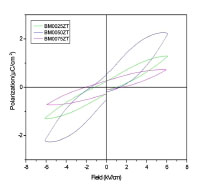 ) shows the hysteresis loops measured for a field maximum of 6.2 KV cm-1, resulted to be the rupture field for the BM0050ZT sample. This value is significantly inferior to those obtained for the rest of the studied materials. The tendency for the formation of a double hysteresis loop in the BM0050ZT sample is appreciable but not so in the BM0025ZT and BM0075ZT, where these are, moreover, the least dielectric losses. In a first grade phase transition materials, it is common to see in the vicinity of the transition temperature the hysteretic loop change from simple to a double loop closed in the center [13, 14], but in a previous result obtained by us, it was determined that BMZT system has a diffuse phase transition, putting off consideration the previous option as explication for the phenomenon in sample BM0050ZT.
) shows the hysteresis loops measured for a field maximum of 6.2 KV cm-1, resulted to be the rupture field for the BM0050ZT sample. This value is significantly inferior to those obtained for the rest of the studied materials. The tendency for the formation of a double hysteresis loop in the BM0050ZT sample is appreciable but not so in the BM0025ZT and BM0075ZT, where these are, moreover, the least dielectric losses. In a first grade phase transition materials, it is common to see in the vicinity of the transition temperature the hysteretic loop change from simple to a double loop closed in the center [13, 14], but in a previous result obtained by us, it was determined that BMZT system has a diffuse phase transition, putting off consideration the previous option as explication for the phenomenon in sample BM0050ZT.
 |
Fig. (8) Hysteresis loops corresponding to BM0025ZT, BM0050ZT and BM0075ZT samples obtained at 6.2 KV cm-1. |
We observe the low polarization values that characterize the BM0025ZT, BM0050ZT and BM0075ZT sample respect to BZT005. Nevertheless, what we have are very poor responses compared to those of BZT005. This behaviour must be associated with an increase in the ionic disorder of the perovskita structure site given by the inclusion of the Mg ion in the system that will occupy the same crystallographic than the Mg in our system. Due to the difference in their ionic radii, a distortion takes place, if we add to this, that location B is occupied by the elements Zr and Ti in a random manner (Zr presents a fixed percentage of 0.05%), we obtain as consequence of these two defects in the network, a weakening in the dipolar long range interactions [16, 18], consequently reducing the stability of the ferroelectric phase. These results suggest that at room temperature small antiferroelectric regions appear in the ferroelectric matrix, as consequence, the dielectric losses became smaller, due to the weak hysteretic nature of the antiferroelectric state [19, 20]. The shape of the hysteresis loop corresponding to the BM0050ZT sample, suggests the coexistence of anti-ferroelectric and ferroelectric phases in the material, with predominance of the latter. We cannot say the same about the BM0025ZT and BM0075ZT samples, this may be explained as: by the decreasing grain size, antiferroelectric domain walls become difficult to form in the grain, and the domain rotation contribution to the strain becomes smaller [21], The decrease of strain with the grain size greater than 5 μm is attributed to the grain boundary which could clamp the transformation strain. The average diameter of our samples are closed to the frontier where two diferents procces clamp the transformation strain, explaining why a presense of an antiferrolectric phase is suggested in BM0050ZT sample, and not in BM0025ZT and BM0075ZT samples. However a thin dielectric hysteretic is a desirable response for electro-optics applications, characterized by a birefringence when an electric field is applied, but relaxing to an isotropic state (non- birefringence) when the electric field is removed, showing a poor remnant [22].
CONCLUSIONS
Through the conventional ceramic the Ba1-x Mgx(Ti0.95Zr0.05) O3 systems was obtained, where x has the values 0.025, 0.05 and 0.075. From the X-ray the presence of a pseudocubic phase corresponding to a perovskita structure was determined with the inclusion of Mg in BZT005 system. The diffuse phase transition observed in BZT remains when Mg is used, and increases with Mg concentration in the 0<Mg% <0,075 range. The temperature for the maximum dielectric permittivity shift closer to room temperature when Mg adding is increased. A low response in terms of the remnant polarization was found. A discussion around some appears evidences of the presence of antiferroelectrics regions in the matrix was carried out, given that the Ba2+ ion substituted by Mg2+ ion in the A-site provoke an electromechanical stress, increasing the short-range interaction forces, and not well appreciate given the small values of the grain size obtained. A more complete work is proposed, where the size of the grain must be regulated, and a temperature study is suggested.
ACKNOWLEDGEMENTS
This work was partially sponsored by CoNaCyT Proj. No. 47714-F and PAPIIT-DGAPA UNAM IN102908. We thank, P. Casillas, I. Gradilla, F. Ruiz, E. Aparicio, A. Tiznado and E. Medina for their technical help and O. Contreras for his help with the sample preparation.
